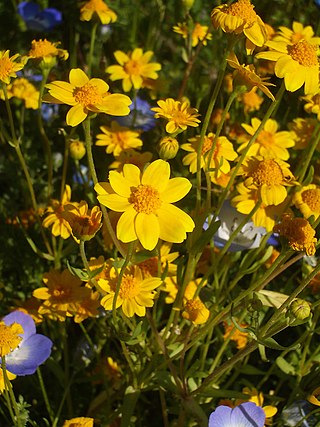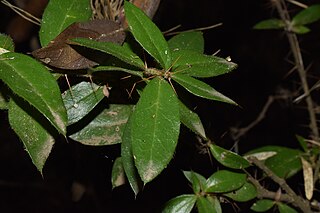
Calyceraceae is a plant family in the order Asterales. The natural distribution of the about sixty species belonging to this family is restricted to the southern half of South America. The species of the family resemble both the family Asteraceae and the Dipsacaceae.

Scalesia is a genus in the family Asteraceae endemic to the Galapagos Islands. It contains fifteen species that grow as shrubs or trees. This is unusual, because tree species are uncommon in Asteraceae. The genus Scalesia resulted from a blunder by Arnott who named it in honour of "W. Scales Esq., Cawdor Castle, Elginshire" but discovered after publication that the name should have read 'Stables', after Scottish botanist, William Alexander Stables (1810–1890).

Lasthenia, commonly known as goldfields, is a genus of flowering plants family Asteraceae. The genus is named after Lasthenia of Mantinea, a cross-dressing female pupil of the ancient Greek philosopher Plato.

The puna grassland ecoregion, of the montane grasslands and shrublands biome, is found in the central Andes Mountains of South America. It is considered one of the eight Natural Regions in Peru, but extends south, across Chile, Bolivia, and western northwest Argentina. The term puna encompasses diverse ecosystems of the high Central Andes above 3200–3400 m.

Sonchus subg. Dendroseris is a subgenus of flowering plants in the genus Sonchus, family Asteraceae. It was formerly treated as the genus Dendroseris, with one species sometimes placed in Thamnoseris. All the species placed in the subgenus are endemic to either the Juan Fernández Islands or the Desventuradas Islands in the South Pacific, both part of Chile.
Sonchus sinuatus, synonym Dendroseris macrantha, is a species of flowering plant in the family Asteraceae. It is endemic to the Juan Fernández Islands of Chile. It is threatened by habitat loss.

Sonchus splendens, synonym Dendroseris macrophylla, is a species of flowering plant in the family Asteraceae. It is endemic to the Juan Fernández Islands of Chile. It is threatened by habitat loss.

Sonchus phoeniciformis, synonym Dendroseris pinnata, is a species of flowering plant in the family Asteraceae. It is endemic to the Juan Fernández Islands of Chile. It is threatened by habitat loss.

Leucheria suaveolens, the vanilla daisy, is a species of flowering plant in the family Asteraceae. It is endemic to Falkland Islands. Its natural habitats are temperate shrubland, rocky areas, and rocky shores. It is threatened by habitat loss.

The Mutisioideae are a subfamily in the plant family Asteraceae that includes about 630 species assigned to 44 different genera. This subfamily is mainly native in South America, except for Adenocaulon, Chaptalia, Gerbera, Trichocline, which have species in all continents other than Europe and Antarctica. Common characters are the deeply incised corollas of the disc florets, with five lobes, sometimes merged in two lips, flower heads with overlapping involucral bracts, anthers with tails and pointy tips, the styles usually stick far out of the florets and are essentially hairless. Most species are herbs, but some are vines, shrubs, or small trees.

The Antarctic Floristic Kingdom, also the Holantarctic Kingdom, is a floristic kingdom that includes most areas of the world south of 40°S latitude. It was first identified by botanist Ronald Good, and later by Armen Takhtajan. The Antarctic Floristic Kingdom is a classification in phytogeography, different from the Antarctic realm classification in biogeography, and from Antarctic flora genera/species classifications in botany.

Dasyphyllum excelsum is a species of flowering plant in the family Asteraceae. This species is endemic to Chile, occurring from Quillota to Cauquenes between 190 and 800 m above sea level, a specific location of occurrence being in central Chile within the Cerro La Campana forests in association with the endangered Chilean wine palm, Jubaea chilensis.

Sonchus laceratus, synonyms including Dendroseris lacerata and Thamnoseris lacerata, is a species of plants in the daisy family Asteraceae. It is endemic to the Desventuradas Islands in the South Pacific, part of Chile. It is commonly known as the pachycaul tree.

Leptocarpha is a monotypic genus of flowering plants in the family Asteraceae. It is endemic to central Chile.
Perdicium is a genus of plants in the tribe Mutisieae within the family Asteraceae. It includes two species native to the Cape Provinces of South Africa.
Calopappus is a monotypic genus of flowering plants in the family Asteraceae, containing the single species Calopappus acerosus. It is endemic to central Chile, where it occurs in the Andes.

The Southern Andean steppe is a montane grasslands and shrublands ecoregion occurring along the border of Chile and Argentina in the high elevations of the southern Andes mountain range.

Gamochaeta is a genus of flowering plants in the family Asteraceae. There has not always been agreement among botanists regarding its status as a recognized genus, but it has become more accepted in recent years. It currently includes many plants that previously belonged in genus Gnaphalium. Like many species of Gnaphalium, many Gamochaeta are called cudweeds or everlastings.

Haplopappus foliosus is a species of flowering plant in the family Asteraceae that is endemic to Chile.

Leucheria is a genus of flowering plants in the family Asteraceae.
















